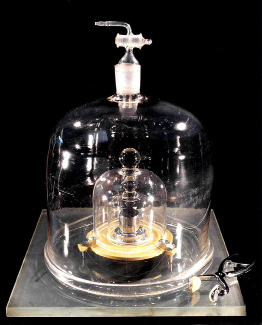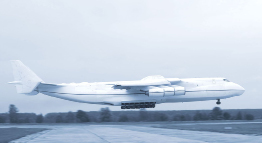Module 1
1. Module 1
1.19. Page 4
Module 1: The International System of Units (SI)
Bringing Ideas Together
A kilogram is equal to the mass of a certain cylinder of platinum-iridium alloy kept at the International Bureau of Weights and Measures in France.
The base unit of mass in SI (metric) is the kilogram (kg). Originally, in 1796 in France, during the French Revolution, the kilogram was defined as the mass of 1 L of ice water. A few years later, it was redefined as the mass of 1 L of water at 4°C, the temperature when water is its most dense. However, for uniformity, metal cylinders were manufactured that came as close as possible to this mass.

Copyright © BIPM. Reproduced with permission.
The metal cylinder used today was manufactured in the 1890s. It is made from a metal alloy of platinum and iridium because of the alloy’s stability. This cylinder is called the International Kilogram Prototype and is kept in a vault at the Internal Bureau of Weights and Measures (BIPM) in Sèvres, France, near Paris. This is the standard used by science, industry, and commerce around the world.
Scientists are in the process of trying to agree on a different way of defining the kilogram to make it easier to duplicate. Agreement may be reached in 2011.
In the problems in this lesson, the mass of 1 L of water provides a very good approximation of the kilogram. If you have access to a litre of milk, or perhaps a litre of bottled water or pop, go and take it out of the fridge now. When you lifted the container, you lifted a 1-kg mass. What other everyday objects can you name that have about a 1-kg mass?
Example 1
Marty weighed himself on a bathroom scale. He weighed 61 kg. Later that day, at the store where he works, he lifted five dozen bottles of water into the trunk of a customer’s car. He told the customer he just lifted his own weight in water. Was Marty correct in what he said?
Solution
Five dozen bottles is 5 × 12, or 60 bottles. Each bottle contains 1 L, and 60 L of water has a mass of 60 kg, which is close to Marty’s weight. Including the containers, the total would be at least 61 kg. Marty was telling the truth!
Comparing Units
So, how do different units of mass relate to one another?
There are two common units derived from the kilogram. What does the prefix kilo mean in kilogram? How many grams are there in a kilogram?
Remember that 1 L of water has a mass of 1 kg. But 1 L = 1000 mL and 1 kg = 1000 g. So, 1 mL of water has a mass of 1 g.
Do you remember what the volume of 1 mL of water is?

A small grape or raisin has a mass of about 11 grams. Can you think of other objects that are 1 g in mass?
Example 2
A Canadian dime has a mass of 1.75 grams.
- Express the mass of the dime in kilograms.
- About how many dimes are there in 1 kg?
Solution

- 1 kg = 1000 g
1 dime = 1.75 g
So, the number of dimes in 1000 g is

There are about 571 dimes in a kilogram, or a total of $57.10 in dimes.
 Try This
Try This
The previous examples showed that converting among SI units of mass involves only powers of 10. So, mass unit conversion only involves the movement of the decimal. See this happen in “Mass Conversions.” Go back to Example 2 and use “Mass Conversions” to confirm the conversion from grams to kilograms.
Large Masses
That is, 1 t = 103 kg.
Another unit derived from the kilogram is the tonne (t). The tonne is used for measuring large masses, such as the mass of concrete in a bridge, the mass of goods in a truck and trailer unit, or the mass of an airplane.
In the lesson on volume, you explored the number of litres in 1 m3. Do you remember that 1 m3 = 1000 L? So, what would the mass be of 1 m3 of water?
Example 3
A Canadair 415 water bomber used in fighting forest fires can hold 6137 L of water. What is the mass, in tonnes, of water it can release?
Solution
The mass of 6137 L of water is 6137 kg.
![]()
The water bomber holds 6.137 t of water in its tanks.
Example 4

© joyfull/shutterstock
An Antonov 225, the world’s largest cargo plane, can carry 250 t. What is its cargo capacity in kilograms?
Solution
![]()
The Antonov can haul 250 000 kg.
 Self-Check
Self-Check
Do the following questions. Where conversion between kilograms and grams are involved, you may use “Mass Conversions” to help you.
SC 1. Every day, Maria drinks at least 1.75 L of water. What mass of water would she drink in 2013 measured in
- kilograms
- grams
SC 2. The blue whale can grow to over 170 000 kg. What is that mass in tonnes?
SC 3. The Darias’ baby was 3125 g at birth. How much did the baby weigh in kilograms?
SC 4. The Canadian $1 coin is 7 g in mass. In 2007, the Royal Canadian Mint struck 36 424 000 of these coins. What is the total mass of all of these coins in tonnes?
SC 5. A package of 50 cheese slices weighs 0.5 kg. What is the mass, in grams, of each slice?
SC 6. During the winter, there are over 1400 km of ice roads and ice crossings in the Northwest Territories. The total weight of a truck and cargo travelling to Inuvik could weigh over 45 t. What is 45 t in kilograms?
SC 7. A package of meat is labelled 1.37 kg. What is its weight in grams?
SC 8. Convert 67 000 g to tonnes.
SC 9. A 2-kg sausage is divided into 100-g portions. How many portions are there?
SC 10. Cream puffs are advertised by a local store for $3.49 for a 250-g package. What is the price per kilogram?
 Mastering Concepts
Mastering Concepts
If you have mastered the concepts of this lesson and would like a challenge, try these questions. You might use “Mass Conversions” to help you make the conversion between mass units. When you are finished, check your answers.
The quantity of active ingredients in a pill or vitamin tablet is often quoted in milligrams (mg).
MC 1. What does the prefix m in mg mean?
MC 2. How many milligrams are there in 1 g?
MC 3. A baby Aspirin contains 75 mg of medication. Convert 75 mg to grams.